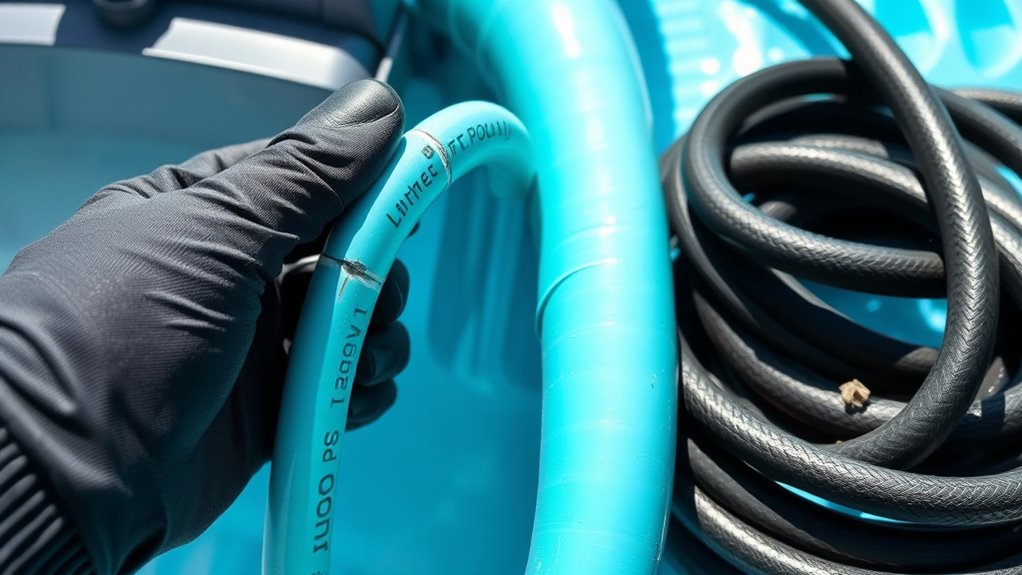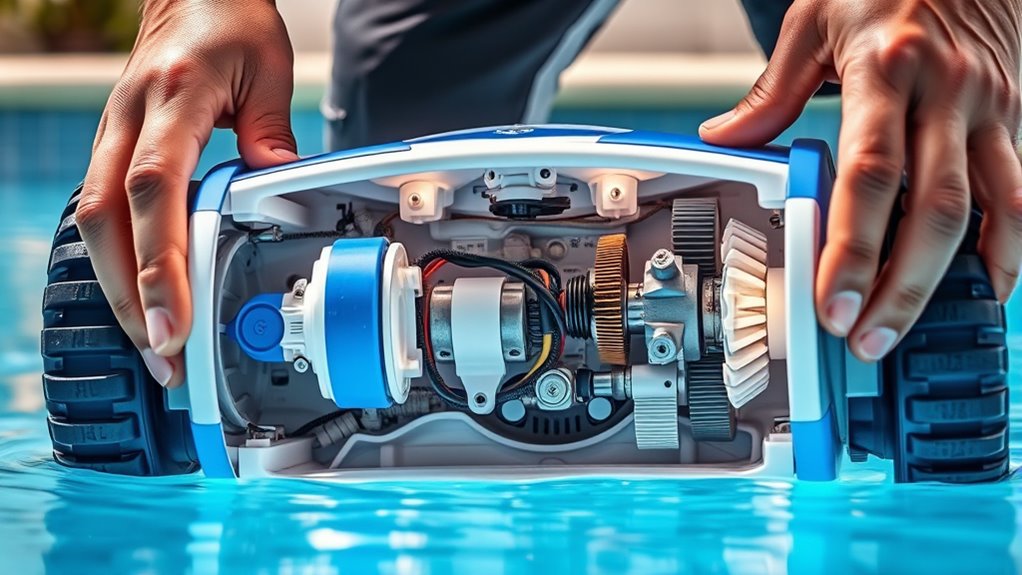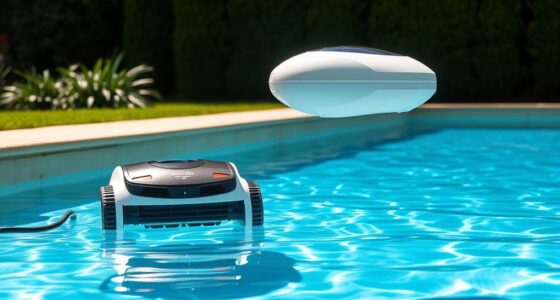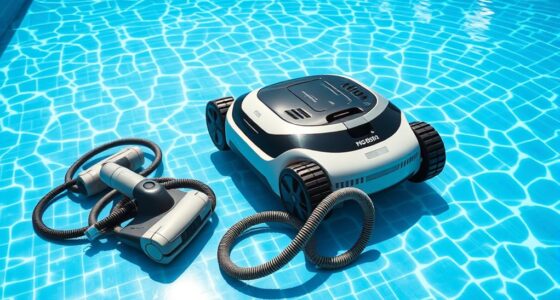If your automatic pool cleaner isn’t working properly, start by checking the power connection, water level, and debris strainers to guarantee water flow isn’t blocked. Inspect hoses, cables, and moving parts, replacing or cleaning them if needed. Make sure brushes and skimmer inlets are clear of debris, and verify the drive motor and wheels are functioning smoothly. Regular maintenance can fix many issues—keep going to learn more tips to get your cleaner back in action.
Key Takeaways
- Check power connections, circuit breaker, and verify the unit is plugged in properly.
- Inspect hoses, cables, and water flow for obstructions or leaks.
- Clean or replace brushes, skimmer basket, and filters regularly.
- Test wheels and drive motor for smooth operation and listen for unusual noises.
- Reset the cleaner, update software if needed, and perform routine maintenance.
Checking the Power Source and Connections

Before troubleshooting your pool cleaner, make sure it’s properly connected to a power source. Check if there’s a power outage in your area, as this could be the cause of the issue. If the power is working elsewhere, examine the circuit breaker dedicated to your pool equipment. Sometimes, the breaker trips due to overload or a short circuit, cutting off power to the cleaner. Reset the breaker by switching it off and then back on. Ensure that the power cord is securely plugged into the outlet. Loose connections can prevent your cleaner from functioning properly. If everything appears in order but the cleaner still doesn’t start, test the outlet with another device to confirm it’s providing power. Addressing these basics can often resolve power-related problems quickly. Additionally, inspecting the security zone of your electrical setup can help identify underlying issues that might affect your pool equipment’s performance. Regularly checking the electrical system and ensuring proper electrical connections can prevent future malfunctions and prolong the lifespan of your pool cleaner. Performing these checks can also help identify potential electrical faults before they cause more serious issues. It’s also advisable to verify that your device’s filtration system is clean and unobstructed, as debris buildup can sometimes affect operation.
Inspecting and Cleaning the Brushes and Skimmer Intake

Start by checking the condition of your pool’s brushes to guarantee they aren’t worn or damaged. Next, clean out the skimmer intake to prevent blockages that can affect suction. If you notice any worn components, replace them promptly to keep your cleaner operating smoothly. Regular maintenance, including inspecting filtering processes, can help ensure optimal performance of your automatic pool cleaner. Additionally, reviewing your IRA withdrawal strategies periodically can prevent unexpected tax liabilities and maximize your savings. Staying informed about AI discoveries may also inspire innovative upgrades to your pool cleaning technology. Understanding automation in business can provide insights into how automated systems optimize efficiency and might be applied to your pool maintenance routines. Moreover, incorporating noise reduction technology into your cleaning equipment can make the process quieter and more comfortable.
Checking Brush Condition
To guarantee your pool cleaner operates effectively, it’s essential to regularly inspect and clean the brushes and skimmer intake. Start by checking the brush inspection to see if the bristles are worn, bent, or missing. Worn brushes reduce cleaning efficiency, so consider bristle replacement if needed. When inspecting, look for any debris or buildup that could hinder movement. Clean the brushes thoroughly with a hose to remove dirt and algae. If you notice damaged or severely worn bristles, replace them promptly to maintain ideal cleaning. Regular maintenance ensures your cleaner functions smoothly. Remember, well-maintained brushes make a significant difference in cleaning performance and prolong your equipment’s lifespan. Keep an eye on these details for hassle-free pool maintenance. Proper filter maintenance also plays a crucial role in overall pool cleaning efficiency. Additionally, understanding family photoshoot fails can help you avoid awkward moments during your next poolside photo session. For optimal results, consider checking the suction power and cleaning modes to ensure your cleaner is operating at peak performance.
Cleaning Skimmer Intake
Have you checked your skimmer intake lately? Regularly inspecting and cleaning the skimmer basket ensures ideal removal of debris, preventing clogs that can hinder your pool cleaner’s performance. Remove the basket and clear out leaves, bugs, or other debris that may have accumulated. While doing so, inspect the skimmer intake for any obstructions or buildup that could restrict water flow. Remember, a clean skimmer basket helps maintain proper pool water chemistry by allowing balanced circulation and filtration. If you notice algae or dirt on the skimmer intake, clean it thoroughly with a brush or cloth. Keeping these components free of debris improves the efficiency of your automatic pool cleaner and helps maintain clear, healthy water. Additionally, understanding the water flow in your pool system can help you identify potential issues early and ensure optimal performance of your cleaner. Ensuring proper traffic flow within your pool system is essential for maintaining effective circulation and preventing common issues such as stagnation or uneven cleaning. Regularly monitoring and adjusting your pool’s circulation system can further enhance overall cleaning efficiency and water quality.
Replacing Worn Components
Regularly inspecting and cleaning your pool’s brushes and skimmer intake helps prevent wear and tear that can reduce cleaning efficiency. Worn or damaged parts can hinder your cleaner’s performance, so replacing them is essential. When doing this, check for frayed brushes or debris buildup, which can block water flow. Also, ensure your filter maintenance is up to date to keep the system running smoothly. Proper chemical balance minimizes algae and debris that can cause wear. Additionally, following recommended filter replacement schedules ensures your system remains effective over time. Swapping out stiff or cracked brushes for new ones, clearing debris from the skimmer intake, checking and replacing damaged or worn brushes, and maintaining a proper filter cleaning schedule all contribute to keeping your pool cleaner operating at its best. Incorporating proper maintenance routines can further enhance the longevity of your pool cleaner and prevent costly repairs. Regular GMC tuning practices can also help optimize your pool cleaner’s performance by ensuring all components work harmoniously. Moreover, using various home decor organization solutions can help keep your pool area tidy, reducing debris buildup that can affect your cleaner’s operation. Additionally, understanding the importance of sound design principles can lead to more effective troubleshooting by identifying unusual noises indicating worn parts.
Examining the Hose and Cable for Damage or Blockages

Start by inspecting the hose and cable for tears or cracks that could cause leaks or malfunctions. Next, check for any blockages in the passages that might restrict water flow or movement. Finally, make sure the cable is securely connected to prevent interruptions during cleaning. Additionally, ensure that the hose material is durable and in good condition to withstand regular use, which can prolong the lifespan of your cleaner material durability. Regularly inspecting and maintaining these components helps prevent clogging and extends the overall performance of your pool cleaner.
Inspect for Tears or Cracks
To guarantee your pool cleaner operates smoothly, it’s vital to check the hose and cable for tears or cracks. Over time, material durability can weaken, especially if the hoses are exposed to UV resistance issues. Inspect carefully for any visible damage, as cracks or tears can hinder performance. Damage might not always be obvious, so look closely at all parts. Here are some tips to keep in mind:
- Check for any splits or holes in the hose material
- Look for frayed or worn-out sections
- Examine the cable for cuts or exposed wires
- Ensure the connections are secure and not cracked
Addressing small tears early helps prevent leaks and further damage. Regular inspection keeps your pool cleaner functioning efficiently and prolongs its lifespan.
Check for Blocked Passages
Have you checked the hose and cable for blockages or damage lately? Blocked passages can considerably hinder your pool cleaner’s performance by restricting water flow. Carefully inspect the entire length of the hose for any debris, leaves, or buildup that might be clogging it. Look for kinks, twists, or cracks that could cause water to bypass or slow down. Similarly, examine the cable for signs of wear, cuts, or tangles, as damage can interfere with the cleaner’s movement and water flow. Clearing any obstructions and repairing damaged sections ensures that water flows smoothly through the system. Proper water flow is crucial for maximum cleaning efficiency, so taking time to check these components can resolve many common issues before they escalate.
Ensure Proper Cable Connection
Ensuring a proper cable connection is essential for your pool cleaner to operate effectively. Start by inspecting the cable and hose for damage or blockages that could disrupt power or movement. Loose or broken cables can cause the cleaner to stop working or operate inefficiently. Check the connector compatibility to make sure all connections fit snugly and securely. Regular cable maintenance prevents wear and tear, extending the lifespan of your cleaner.
Here are some tips:
- Examine the entire cable for cuts or frays
- Ensure connectors are tightly plugged in
- Remove any debris or obstructions from the hose
- Replace damaged cables or connectors promptly
Testing the Drive Motor and Wheels

Wondering if your pool cleaner’s drive motor and wheels are functioning properly? Start by performing drive motor testing—listen for unusual noises or lack of motor response when the cleaner is powered on. If the motor seems unresponsive, it may need replacing. Next, inspect the wheels closely. During wheel inspection, look for cracks, debris buildup, or worn-out treads that could hinder movement. Spin the wheels manually to check for smooth rotation; stiff or stuck wheels indicate a problem. Ensuring the wheels turn freely and the motor runs quietly helps confirm your cleaner’s drive system is working correctly. Address any issues you find promptly to keep your pool cleaner operating efficiently and prevent further damage.
Verifying the Pool’s Water Level and Debris Strainers

To keep your pool cleaner functioning effectively, you need to verify that the water level is appropriate and that debris strainers are clear. An incorrect pool water level can prevent proper suction, while clogged debris strainers hinder debris collection. Check that the water level is about halfway up the skimmer opening. If it’s too low, add water; if it’s too high, drain some. For debris strainers, remove the skimmer basket and cleaner’s inlet strainer, then clean out leaves, dirt, and other blockages. Regular maintenance ensures peak performance. Remember to inspect these components before troubleshooting other issues, as they’re vital to your cleaner’s efficiency. Keeping the pool water level balanced and debris strainers clean prevents many common cleaning problems.
Resetting or Reprogramming the Cleaner’s Settings

If your pool cleaner isn’t operating as expected, resetting or reprogramming its settings can often resolve the issue. First, consult the user manual to understand how to access your cleaner’s controls. Many models require you to reset the device by pressing a specific button or combination. Sometimes, software updates are necessary to improve performance or fix bugs; check the manufacturer’s website for updates and instructions. Reprogramming your cleaner’s schedule or cleaning modes can also help optimize its operation. Follow the steps outlined in your manual to adjust settings, ensuring your cleaner runs efficiently. After resetting or reprogramming, test the cleaner to see if performance improves. Regularly updating the software and reviewing settings can prevent future issues and extend your cleaner’s lifespan.
Replacing or Repairing Worn Components

Worn components are a common cause of malfunction in pool cleaners, and replacing or repairing them can restore peak performance. Over time, parts like brushes, wheels, or the drive belt can wear out, affecting surface skimming and debris pickup. When you notice reduced cleaning efficiency, inspect these parts first. You might also check the brushes for buildup of pool chemicals or debris that hinder movement. Replacing worn components is straightforward and can save you money on a new cleaner. Consider these tips:
- Regularly inspect and replace brushes and wheels
- Clean or replace clogged or damaged hoses
- Check for cracks or tears in the drive belt
- Ensure the filter and surface skimming components are clear
Keeping components in top shape ensures your cleaner runs smoothly and keeps your pool sparkling.
Frequently Asked Questions
How Often Should I Schedule Maintenance for My Pool Cleaner?
You should schedule maintenance for your pool cleaner regularly to extend its lifespan. Typically, perform a maintenance checklist every 1-2 months, depending on usage and pool conditions. Regular upkeep helps prevent issues and keeps your cleaner running efficiently. By staying on top of maintenance, you ensure your pool cleaner remains effective, reducing the need for repairs and maximizing its lifespan. Consistent care is key to a clean, hassle-free pool experience.
Can Algae or Mineral Buildup Affect Cleaner Performance?
Algae or mineral buildup can definitely affect your pool cleaner’s performance. Algae prevention helps keep your pool cleaner running smoothly by reducing debris that can clog it. Mineral buildup removal is essential, as it can cause parts to stick or malfunction. Regularly brushing the pool and using appropriate cleaning agents will help maintain peak performance. Keep these issues in check, and your cleaner will work more efficiently, saving you time and effort.
What Safety Precautions Should I Follow During Repairs?
Did you know that nearly 30% of pool injuries happen during repairs? When repairing your pool cleaner, always wear safety gear like gloves and goggles, and guarantee electrical safety by unplugging the device before starting. Keep your workspace dry, avoid working alone, and follow manufacturer instructions carefully. These precautions protect you from electrical shocks, cuts, and other injuries, making repairs safer and more efficient.
How Do Environmental Factors Impact Cleaner Efficiency?
Environmental factors markedly impact your automatic pool cleaner’s efficiency. Changes in water chemistry, like pH and chlorine levels, can affect its performance, making it less effective at cleaning. Additionally, debris accumulation from leaves or dirt can clog the cleaner or hinder movement. You should regularly monitor water chemistry and remove debris to keep your cleaner working smoothly, ensuring ideal cleaning and extending its lifespan.
Is Professional Servicing Necessary for Complex Repairs?
Think of your pool cleaner as a delicate clock, needing expert hands for complex repairs. While DIY fixes might seem tempting, they can lead to further issues. Professional servicing guarantees your cleaner’s intricate parts are properly diagnosed and fixed, saving you from costly mistakes. Considering cost, investing in expert help often pays off, preventing damage that could escalate repairs and keeping your pool pristine without the hassle of trial and error.
Conclusion
So, after all that troubleshooting, you might think your cleaner’s just playing hard to get. Ironically, the solution could be as simple as a loose connection or a clogged hose. Sometimes, fixing your pool cleaner feels more like a treasure hunt than maintenance. But don’t worry—if all else fails, it’s probably just waiting for you to discover that the real problem was a tiny, overlooked detail all along. Happy cleaning!









